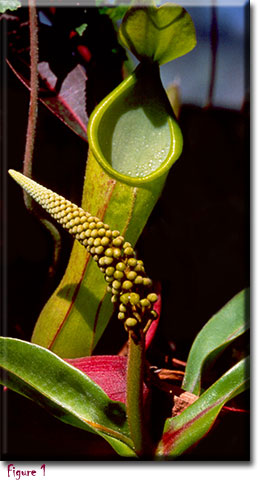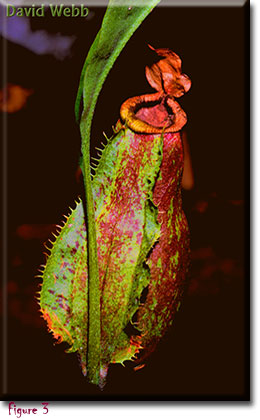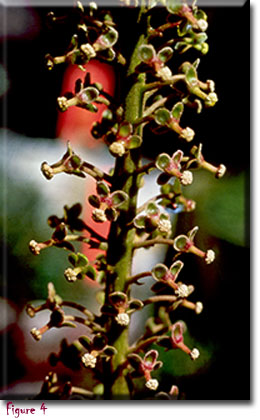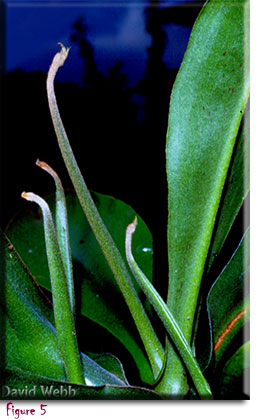 TRAP TYPE: Pitfall Trap
TRAP TYPE: Pitfall Trap
Currently 90 listed species (click here) occupying tropical habitats in Australia, Madagascar, Papua New Guinea, the Seychelles, Southeast Asia and Sri Lanka.
Nepenthes, a native of Southeast Asia and Australia, forms pitchers (cups) that hang from trees. Its pitcher is similar to that of the North American pitcher plant in that it relies on a pool of water to trap its prey. It has a most unusual leaf that first looks like a normal leaf, then develops a tendril at its tip, and finally the tip of the tendril develops an amazing pitcher. It gains support by twining the tendril around another plant. The trap, like our own pitcher plant, lures its prey into the pitfall trap by a combination of decaying odors and sometimes a red coloration. As the pitcher develops, it swells and droops due to its weight.
As it matures, it suddenly begins inflates with air. Once inflated it begins to fill with liquid, then opens, revealing the enticing interior. The top of the trap has a lid that initially covers the pitcher until growth is complete. When the leaf is fully grown, the lid opens and the trap is ready.
They attract insects with the odor of nectar. Once inside, the insect finds it cannot get a grip on the walls of the pitcher because a flaky wax on the interior surface peels off as it struggles to climb. Eventually, it falls into the water and struggles to escape. The motion caused by the struggle stimulates digestive glands to release a digestive acid. This acid is so strong that a midge will disappear within hours. The largest of these, the Rajah pitcher, is able to digest mice! Like our own pitcher plant, this one too has its live inhabitants, the largest of which is a small crab.
Insect larvae feed on the decaying remains of prey. Others live in the upper levels and dip down occasionally to seize one of the larval inhabitants. In one case, the plant provides a chamber in its stem where ants live. The ants venture to the pitchers, grab some of the decaying prey, and sit on the lip of the pitcher to dismember it. As they break apart the body, pieces fall back into the pitcher's awaiting pool, where the now smaller fragments decay more quickly than would a whole insect. As you can see, this page is being developed. There are currently 91 listed species of Nepenthes.
Ca. 90 Listed Species:
N. adnata Tamin & Hotta ex Schlauer, 1994 | N. alata Blanco, 1837 | N. albo-marginata Lobb ex Lindl., 1849 | N. ampullaria Jack, 1823 | N. anamensis Macfarlane, 1908 | N. argentii M.Jebb & Cheek, 1997 | N. aristolochioides M.Jebb & Cheek, 1997 | N. bellii Kondo, 1969 | N. benstonei C.Clarke, 1999 | N. bicalcarata Hook.f., 1998 | N. bongso Korth. | N. boschiana Korth. | N. burbidgeae Hook.f. ex Burb., 1882 | N. campanulata Sh.Kurata, 1973 | N. clipeata Danser, 1928 | N. danseri M.Jebb & Cheek, 1997 | N. deaniana Macfarlane, 1908 | N. densiflora Danser, 1940 | N. diatas M.Jebb & Cheek | N. distillatoria L., 1753 | N. dubia Danser, 1928 | N. edwardsiana Low ex Hook.f., 1851 | N. ephippiata Danser, 1928 | N. eustachya Miq. | N. eymae Sh.Kurata, 1984 | N. faizaliana J.H.Adam & C.C.Wilcock, 1991 | N. fallax G.Beck, 1895 | N. fusca Danser, 1928 | N. glabrata J.R.Turnbull & A.T.Middleton, 1984 | N. gracilis Korth. | N. gracillima Ridl., 1908 | N. gymnamphora Reinw. ex Nees, 1824 | N. hamata J.R.Turnbull & A.T.Middleton, 1984 | N. hirsuta Hook.f. | N. inermis Danser, 1928 | N. insignis Danser, 1928 | N. izumiae T.Davis, C.Clarke, & Tamin, 2003 | N. jacquelineae C.Clarke, T.Davis & Tamin, 2001 | N. khasiana Hook.f. | N. klossii Ridl., 1916 | N. lamii M.Jebb & Cheek, 1997 | N. lavicola A.Wistuba & Rischer, 1996 | N. longifolia L.Nerz & A.Wistuba, 1994 | N. lowii Hook.f., 1859 | N. macfarlanei Hemsl., 1905 | N. macrophylla (Marabini) M.Jebb & Cheek, 1997 | N. macrovulgaris J.R.Turnbull & A.T.Middleton, 1988 | N. madagascariensis Poir. | N. mapuluensis J.H.Adam & C.C.Wilcock, 1990 | N. masoalensis R.Schmid-Hollinger, 1977 | N. maxima Reinw., 1824 | N. merrilliana Macfarlane, 1911 | N. mikei B.R.Salmon & R.G.Maulder, 1995 | N. mindanaoensis Sh.Kurata | N. mira M.Jebb & Cheek, 1998 | N. mirabilis (Lour.) Druce | N. mollis Danser, 1928 | N. muluensis Hotta, 1966 | N. neoguineensis Macfarlane, 1910 | N. northiana Hook.f., 1881 | N. ovata J.Nerz & A.Wistuba, 1994 | N. paniculata Danser, 1928 | N. papuana Danser, 1928 | N. pervillei Blume | N. petiolata Danser, 1928 | N. philippinensis Macfarlane, 1908 | N. pilosa Danser, 1928 | N. platychila C.C.Lee, 2002 | N. pyriformis Sh.Kurata | N. rafflesiana Jack, 1823 | N. rajah Hook.f., 1859 | N. reinwardtiana Miq. | N. rhombicaulis Sh.Kurata, 1973 | N. sanguinea Lindl., 1849 | N. sibuyanensis J.Nerz, 1998 | N. singalana Becc., 1886 | N. spathulata Danser, 1935 | N. spectabilis Danser, 1928 | N. stenophylla Mast., 1890 | N. talangensis J.Nerz & A.Wistuba, 1994 | N. tentaculata Hook.f. | N. tenuis J.Nerz & A.Wistuba, 1994 | N. thorelii Lecomte, 1909 | N. tobaica Danser, 1928 | N. tomoriana Danser, 1928 | N. treubiana Warb., 1891 | N. truncata Macfarlane, 1911 | N. veitchii Hook.f., 1859 | N. ventricosa Blanco | N. vieillardii Hook.f. | N. villosa Hook. | N. vogelii Schuit. & de Vogel, 2002

American Journal of Botany abstracts for research papers about Nepenthes.
• Structure and Development of the Pitchers from the Carnivorous Plant Nepenthes alata (Nepenthaceae), T. Page Owen, Jr., Kristen A. Lennon - Volume 86, Issue 10, Pages 1382-1390, October, 1999
• Floral Biology of Nepenthes gracilis (Nepenthaceae) in Sumatra, Makoto Kato - Volume 80, Issue 8, Pages 924-927, August, 1993
• Floral and Fruit Morphology of Nepenthes lowii and N. villosa, Montane Carnivores of Borneo, Robert B. Kaul - Volume 69, Issue 5, Pages 793-803, May/June, 1982




 TRAP TYPE: Pitfall Trap
TRAP TYPE: Pitfall Trap




